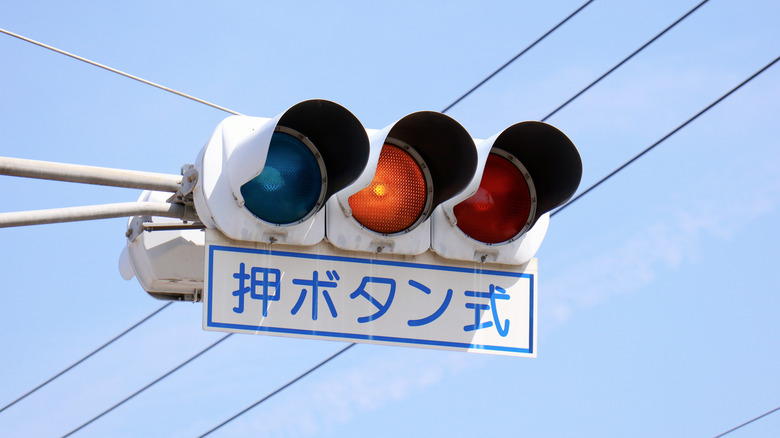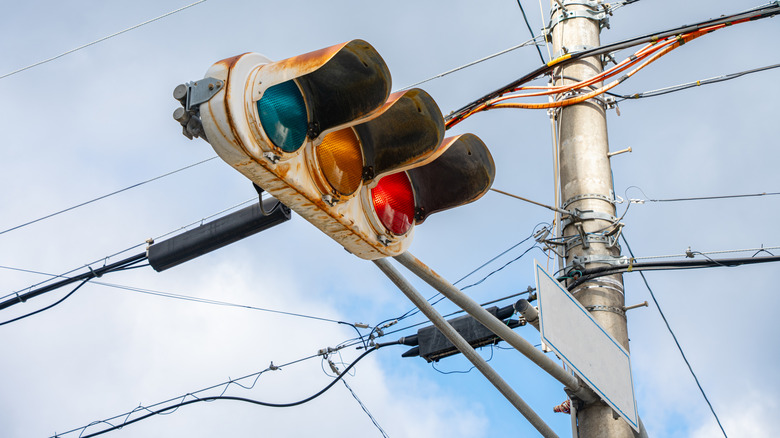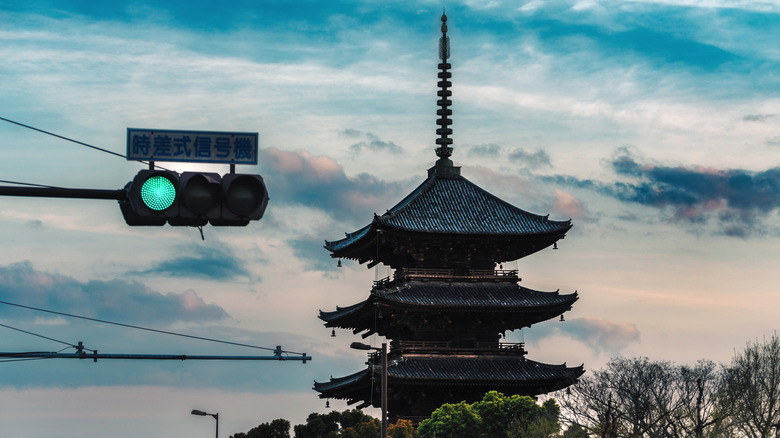Why Traffic Lights In Japan Are Blue Instead Of Green
You might have seen traffic lights in Japan that are a little different to what you're used to. Instead of being red, amber, and green, the last light on the signal might be blue, or perhaps an interesting shade of teal or turquoise. Or, you might have heard people referring to the green light as blue in Japanese, even if the light looks completely green to you. It's not just a different light system: it's a complex history of linguistics and law.
The reason behind this difference isn't just a literal trick of the light or some kind of technology you didn't know about. It's actually based in linguistics. In fact, blue and green can often be synonymised in Japanese, with green traffic signals being called 'aoshingō' (or 'shingou'), which literally translates to blue light. The outcome of this is some slightly incohesive official literature, and a somewhat varied traffic light system around the country.
Bluish and blue-green traffic lights can be seen on roads across Japan, although they can be a fairly rare sight. Some locations where they've been spotted include locations across Honshū like Nikkō, Tochigi, and Kamakura, Kanagawa. They vary in shades from a clear electric blue all the way down to more subtle shades of sage and aquamarine.
Inside the linguistics of blue and green
Historically, the Japanese language has categorised colors slightly differently from how it does now. Part of the reason for this is thought to be the word roots for some colors. Kanji characters are used for many colors in Japanese, which have origins in Hanzi, characters used for writing Chinese languages. The character used for blue in Kanji is the same as 'qīng' in Hanzi, which can be used for 'nature's color', meaning shades of cool blues and greens. The result of this is some ambiguity between the two colors.
The modern Japanese word for green is 'midori', while blue is 'ao'. But, midori is a relatively newer addition to Japanese, so in the past, 'ao' was used instead based on its roots. Consequently, when a compound word is constructed to contextualise an object's color, like a green light, the word for blue is used instead. Therefore, the word for green light is 'aoshingō'. Some dictionaries even list the word 'ao' as meaning azure; a distinctly blue-green shade of cyan not dissimilar from the hue of some traffic lights.
Something that sets midori and ao apart is that midori is technically figurative, and so is used alongside the suffix '-iro'. 'Iro' means colour, so 'midori-iro' translates more along the lines of 'the color of greenery'. 'Iro' isn't used directly with blue to make 'ao-iro', though. Instead, the letter 'i' is added to make 'aoi'. Both 'iro' and 'i' transform the colors from nouns to adjectives, affecting how they can be used grammatically, but they achieve it in slightly different ways. And of course, much like English, Japanese has many other figurative phrases for varying shades of blue and green, from the soft water-colored 'mizu-iro' to the floral 'chigusa-iro'.
Legal codification is a part of why Japan has blue traffic signals
So, the language hasn't always clearly defined the difference between green and blue. And, language is a lot of what makes up law, with words being selected carefully to create policies and mandates. Because of this, the story goes that it was debated whether traffic lights should be mandated to be blue or green in legal statutes, as the language changed. Following that, a traffic law introduced in 1973 mandated that all new traffic lights installed should roughly match how traffic signals tend to work internationally, but with a caveat: the lights should be the bluest green possible.
The Vienna Convention on Road Signs and Signals has been signed by a huge number of countries, unifying how road signs, markings, and traffic lights look around the world. This includes that traffic lights should use the color green to signal 'go'. But Japan is one of several countries that haven't signed the treaty, alongside the United States, Ireland, and Bangladesh.
It's not all about law and linguistics, though. It could also, in part, be due to the technology used for crafting modern traffic lights in Japan. Around 45% of Japan's traffic signals tend to use light-emitting diodes (LEDs) as they tend to be more economical and power-efficient to run, with blue LEDs being especially useful for managing power consumption. And, bluish-green LEDs are even available on the market specifically for traffic operations.


